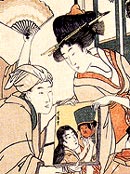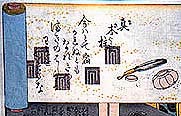

FAQ: What are Genji-mon (源氏紋)?
Eventually, these 25 symbols were expanded to 54, corresponding to the Genji chapters. Other influences on the particular forms of these crests may have been the tally markers or vent patterns of the incense burners used in the ancient game of incense guessing, called awase-kô ("fragrance game" or "incense contest"). The game challenged players to identify burning incense when small slivers of various fragrant tree resins were placed on pieces of mica and burned over charcoal in a kôrô (incense burner). Players had their guesses tallied and the one with the most correct guesses was the winner (some versions of the contest also involved game boards in which correct guesses permitted the players to advance toward the center of the board). The incense game was very popular during the Heian period (794-1185) and the patterns associated with it were often represented in ukiyo-e prints (see the detail from a print by Kuniyoshi, above left). In Edo period printmaking these incense patterns were not always strictly matched with the chapters of the Genji story. For example, they were used occasionally to develop analogies with classical culture or the historical past as part of mitate-e ("view and compare prints" or analogues), combining the historical with the contemporary without necessarily requiring a literal correlation. Thus in ukiyo-e prints the inclusion of Genji-mon may not designate a direct association with a particular chapter in the Genji monogatari, although indirect allusions can often be found (see the discussion about one of Kuniyoshi's "Cloudy Genji" prints). © 1999-2020 by John Fiorillo BIBLIOGRAPHY
Return to FAQ |
Viewing Japanese Prints |
 Genji crests (Genji-mon, 源氏紋) are 54 different rectilinear emblems, each associated with one of the 54 chapters of the Genji monogatari ("Tale of Genji," early eleventh century, written by Murasaki Shikibu). This classic work of literature is considered by
many to be the world's first novel and, in the opinion of some scholars, the finest prose work ever written in Japan. The Genji story
was a very popular subject in ukiyo-e prints. Genji crests (see
Genji crests (Genji-mon, 源氏紋) are 54 different rectilinear emblems, each associated with one of the 54 chapters of the Genji monogatari ("Tale of Genji," early eleventh century, written by Murasaki Shikibu). This classic work of literature is considered by
many to be the world's first novel and, in the opinion of some scholars, the finest prose work ever written in Japan. The Genji story
was a very popular subject in ukiyo-e prints. Genji crests (see